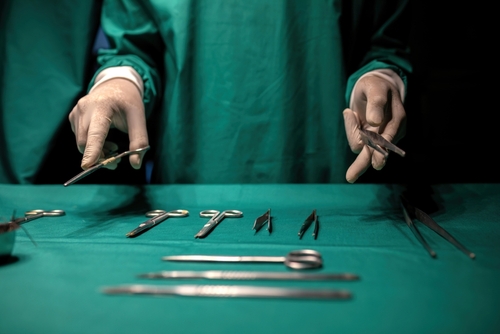Vasectomy, explained: What it is, how it’s done, and the biggest misconceptions about it
Drew Arellano became a hot topic online when he shared that he underwent vasectomy.
The TV host on Monday, April 28 posted a photo of him in a hospital gown, saying that it was his Mother’s Day gift for the love of his life, Iya Villania. They have been married since 2014 and have since welcomed five children: Primo, Leon, Alana, Astro, and Anya.
“Happy late and advanced Mother’s Day to my wife,” he wrote in the caption. “HappyVA-SEC-TO-MEEE!"
According to Villania, Arellano called it a “late gift” for her in his post because it was “supposed to happen last year, but then Anya happened,” she said in her Instagram stories, referring to their fifth baby. “So, this time, he made sure.”
Vasectomy: definition, process, risks, and possible side effects
Urologist Oscar Escudero told PhilSTAR L!fe that vasectomy is a "surgical procedure done for male contraception.”
Dr. Mark Roa, who also specializes in the male reproductive system, said that it’s done by “cutting and sealing the vas deferens—the tubes that carry sperm for the testicles—to prevent sperm from mixing with semen during ejaculation.”
It’s usually performed under local anesthesia. “The surgeon either makes a small incision or uses a no-scalpel technique to access the vas deferens,” he said. “Each vas deferens is cut, and then either tied, cauterized, or clipped to block sperm flow permanently.”
“The skin is then closed, often without the need for stitches,” added Roa.
Per Escudero, the entire procedure takes only an hour or even less.
Most men recover quickly from it, noted Roa. “The first 1–2 days are for rest. The patient may apply ice packs to the scrotum, wear supportive underwear, and avoid strenuous activity,” he explained. “After 3-7 days, light activities can resume, but heavy lifting or vigorous exercise should still be avoided.”
Men are able to get back to normal activities within a week, continued Roa, though some may still feel a bit of discomfort from time to time.
There are, however, some risks and possible side effects that may come with it. Aside from pain, soreness, and discomfort, one may also experience hematoma (minor bleeding inside the scrotum) or infection at the incision site in rare and severe cases.

How effective is it as a birth control method?
Vasectomy is being offered in hospitals like St. Luke's Medical Center as well as PhilHealth-accredited free-standing family planning clinics.
According to Roa, the estimated cost of vasectomy in the Philippines range from P25,000 to P70,000 all in, depending on the facility.
“Vasectomy is over 99% effective as a birth control method, with a one-time-only expense,” Escudero told L!fe.
“It removes the human error seen in daily methods like pills or condoms,” Roa added. “Once cleared, it provides permanent protection without ongoing effort.”
But it's also important to note that the procedure does not provide instant sterility. "It takes around 8–12 weeks and about 20–30 ejaculations to clear existing sperm,” he said.
Macho culture in the Philippines
Vasectomy remains uncommon to this day.
A 2013 study stated that only 1% of Filipino men have undergone the procedure. According to a 2022 report by BusinessWorld, Jackylin D. Robel—regional director of the Commission on Population and Development in the National Capital Region—said that vasectomy is "one of the least methods being availed of" in the country. "I don't know if it reaches 1%," she added.
Data from the Philippine Health Insurance Corp. a year prior showed a total of 69 vasectomy claims in 2021.
"Speaking as a urologist in the Philippines, I think our cultural, religious beliefs, and misconceptions about masculinity contribute heavily to its low uptake," he said. "In my opinion, there is a need to promote awareness about men’s health, particularly sexual and reproductive health."
Per Escudero, men are “hesitant to have it done for fear of losing masculinity and becoming impotent.”
Roa, however, noted that it’s one of the biggest misconceptions about vasectomy. “It does not affect masculinity, libido, or sexual performance,” he stressed. "Testosterone levels, erections, orgasms, and sexual drive remain unchanged because only the sperm is missing from the semen.”
The urologist added that while reversal can be attempted, it is not guaranteed, so vasectomy "should already be considered permanent,” he said.
One's decision to undergo vasectomy can have social implications. In an interview with L!fe, Dr. Vicencio Ballano—the program chairperson of the master’s degree program in sociology at Polytechnic University of the Philippines—said that on the positive side, men who take it can get lauded "for upholding the advocacy of family planning."

He, however, noted that the Philippines is “still a traditional and patriarchal society that values virility and reproductive role of men.”
Given such thinking in the local setting, Ballano said that someone who undergoes vasectomy "can unfortunately become the subject of indirect ridicule and gossip."
“Having vasectomy is perceived as reducing virility and machismo, so they tend to be looked down on especially by macho Pinoys,” he explained. “This is why a very few decide to take it.”
The sociologist noted that it can also affect marriages in the long run. "Remember: Marriage is unfinished before death. In sociology, it’s an ongoing negotiation between spouses—if disagreements arise in line with this in the future and take a turn for the worst, it can dissolve," he said.
"There are still some unforeseen circumstances and one should be prepared especially since it's almost irreversible," added Ballano.



